THE Corporation has outlined a major push to make the City’s iconic historic and cultural landmarks more accessible to people of all ages and abilities over the next five years.
While some venues are leading the way for accessibility, others find themselves struggling to maintain inclusion rates because of their historical setting and design.
But last week the Court of Common Council approved a new Corporate Plan for 2018-2023, which aims to overhaul how inclusion is maximised.
Poor accessibility of public spaces is an issue that many people with disabilities face on a daily basis, and it can result in discouraging them from visiting new places.
A survey conducted by disability charity and access review website Euan’s Guide in February revealed that 92% of disabled people do not feel confident visiting new places because of concerns over access. The same research, using a sample of 700 participants, found that 83% have been affected by poor accessibility.
In spite of these figures, it seems City landmarks are already setting a good example for greater accessibility.
“Generally, reviewers in London have very good things to say about most of the City’s landmarks’ disabled access,” says Antonia Lee-Bapty from Euan’s Guide, which is also the organisation behind Disabled Access Day, an event aimed at highlighting good access that already exists while creating opportunities for people to try something new.
While the popularity of Disabled Access Day swelled year on year after it was first introduced in 2015, organisers decided to turn it into a biannual event, skipping the planned 2018 fixture.
“We realised that to maintain this momentum we needed to give Disabled Access Day the time and resources it required to continue making it the amazing event it has become,” Antonia says.
Nonetheless, while the next official Disabled Access Day will be held on 16 March 2019, St Paul’s Cathedral decided to commemorate the event this year as well, hosting special tours and events, as well as offering free entry for disabled guests and their friends or carers on 10 March.
“We have enjoyed hosting Disabled Access Day in previous years and are keen to continue building on its success, even without the national focus,” said communications officer Hannah Wooley.
While the cathedral floor and the crypt are fully accessible, access to the Whispering Gallery, Stone Gallery and Golden Gallery is via stairs only.
Staff do, however, provide multimedia guides with video fly-throughs of the gallery levels and their views. They have also recently received planning permission for the first major structural addition to the cathedral, two wheelchair friendly ramps.
“St Paul’s tranquil atmosphere and warm welcome makes it one of the most popular landmarks in London among disabled access reviewers,” Antonia says. Another historical landmark adapting to the needs of people with disabilities is Tower Bridge, which already offers full access to those confined to a wheelchair.
“The bridge is somewhat famed amongst our reviewers for its glass floor and surrounds – which enable a full view and excellent vantage points for wheelchair users,” Antonia says.
“And it has a surprisingly good accessible loo high above the Thames.”
Meanwhile, modern sites such as the Barbican and the Museum of London have been praised for offering additional features and special access events, enabling disabled visitors to receive the full experience of visiting their venues. Both have included audio descriptions of their exhibits and screenings for the visually impaired, and induction loops for people with hearing difficulties.
Aside from enabling physical access to their venues, many of the City’s landmarks have created autism-friendly events, specifically designed to enable people on the autism spectrum – and their families, friends or carers – to enjoy what the attractions have to offer. The Museum of London’s ‘Morning Explorers’ events provide an informal atmosphere in which to explore the museum, sensitive to the needs of children under 13 years of age with special requirements.

Autism-friendly early mornings are also returning to Tower Bridge this spring, with the site opening its doors early to enable families to explore the exhibition in a calm, relaxed atmosphere, and take part in craft activities.
“We recognised people with autism as a key group visiting Tower Bridge,” a spokesperson said.
“We’re dedicated to allowing every visitor to enjoy their visit, so we decided to include an event which would enable them to experience the bridge as best suitable to their needs.”
Due to their history and specific characteristics, some of the City’s landmarks have been forced to find new and innovative ways of improving their accessibility, particularly for people with physical disabilities.
One example is the Tower of London, a 1,000-year-old Grade I-listed building and UNESCO World Heritage site. With its difficult stairs and passageways, only the Jewel House is fully accessible for those who use a wheelchair.
Accessible travel agency Sage Travel estimates that only around 20% of the Tower of London can be viewed without having to go up steps.
A spokesperson for Historic Royal Palaces said they are aware of these challenges and are committed to improving access:
“We have just completed a significant review of our access provision and plan to put in place further measures to improve the surfaces to our visitors who use wheelchairs or find the cobbled surfaces challenging as soon as 2018/2019.”
While the Tower does offer concession tickets to disabled visitors, they cost £17.70, which is only £5 less than the full adult admission fee, but disabled visitors are able to bring an accompanying adult/carer free of charge.

The Monument is another landmark that is inherently difficult to navigate. With 311 steps, its views are unavailable to those with mobility difficulties. However, there are plans in place to install a street-level monitor in the near future, which will enable visitors to see the views from the top while on the ground.
Tom Lister is the head of People Friendly Design, an access consultancy based in the City of London, and a wheelchair user himself. He says that when we think of accessibility, we need to look at the bigger picture: “The distances in London, like any other big city, are substantial and a car is useless.
“Most of the Tube stations aren’t accessible, so getting around is the tough bit. The landmarks themselves are exemplars. They normally take accessibility very seriously.”
It’s not necessarily the landmarks, it’s getting to them that proves to be a problem, says Tom, and highlights the lack of accessible pavements as an example: “You would have thought in this day and age that kerbs would be dropped where people want to cross the roads. But specifically, in the City, there are a lot of old roads where there is a lack of them.
“Disabled people need a lot more information than non-disabled people. You just need one step to wreck your entire journey,” said Tom, who also noted that these issues don’t apply only to people with mobility issues.
“We have to remember it’s not only wheelchair users who are disabled. It’s also people with visual impairments, or hearing difficulties, or learning disabilities who are affected by how things are designed and managed.”
So while the City’s landmarks are leading the way in finding innovative accessibility solutions, it is clear that there remains much to be done to make the Capital fully inclusive.
Cover image by Barcex (Creative Commons).







